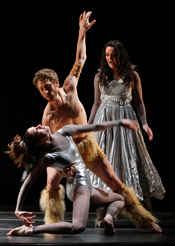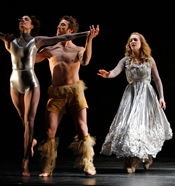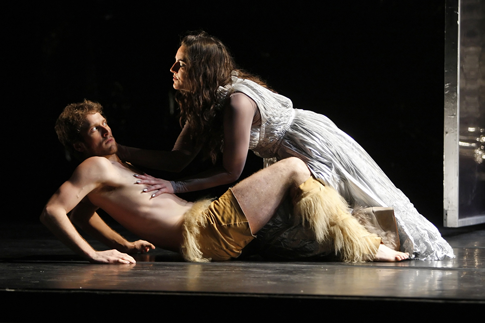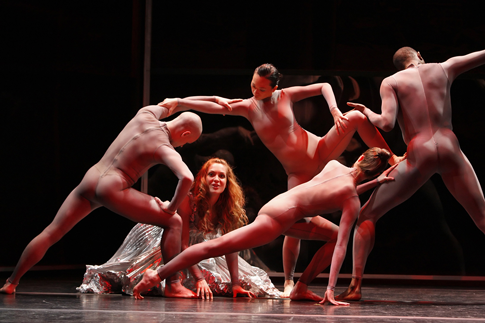
15 May 2008
Gotham Chamber Opera: Ariadne Unhinged
The Gotham Chamber Opera has been delighting opera fans on the Lower East Side for seven years now, one small audience at a time.
Thirty-six years after Sarah Caldwell and the Opera Company of Boston presented the first complete staged performances in the United States, Hector Berlioz’ Les Troyens returned to Boston in triumph in a series of concert performances presented by the Boston Symphony Orchestra under the baton of James Levine to close the BSO’s 2007-2008 season.
Opera companies should practice historic preservation, keeping certain productions forever in the repertory because of their quality and aesthetic value.
Prometeo is so radically different that it’s almost incomprehensible heard from preconceived assumptions of what music “ought” to be.
John Brown might have been a’mouldering in his grave since he was hanged in 1859, but he was resurrected — in body and spirit — on May 3, when the Lyric Opera of Kansas City staged the world premiere of Kirke Mechem’s John Brown.
When Toronto’s Opera Atelier asked her to sing Elettra in Mozart’s Idomeneo Measha Brueggergosman hesitated.
In 2007 it was an experiment; now it’s a new summer festival firmly rooted in fertile Texas turf with a bright view of its second season and of the more distant future as well.
Die Entführung aus dem Serail is too light to be a grand opera, but it makes rather grander demands of its singers than operetta could possibly bear.
English National Opera’s production of Harrison Birtwistle’s ‘Punch and Judy’ is the company’s second collaboration with the Young Vic Theatre — following the premiere of Neuwirth’s ‘Lost Highway’ a few weeks earlier — and remarkably, also the second London production of this early Birtwistle work within a month, the previous one having been at the Linbury Studio Theatre, a collaboration between Music Theatre Wales and the Royal Opera.
Over the years, one tried and true method of packing audiences in to the concerts of Robert Bass’s Collegiate Chorale has been to present concert opera with impressive soloists.
Martha Graham used to say, “In order for there to be dance, there must be something that needs to be danced.”
When the Met presented La Fille du Régiment for Lily Pons during World War II, she sought permission to wave the Cross of Lorraine, symbol of Charles de Gaulle’s Free French, during the Salut à la France in Act II.
Why does one so seldom encounter Dvořák’s Rusalka on stage?
Satyagraha is an odd duck to encounter if you are seeking a traditional opera-going experience or anything like it.
Victor DeRenzi is a man of convictions — and of courage. Given his commitment to tradition, you might call DeRenzi, artistic director of Sarasota Opera since 1982, conservative.
With what might (if one were risking facetiousness) be termed a “false-set” of four countertenors in the cast, this was always going to be an intriguing production of Handel’s Giulio Cesare for aficionados of a voice type which has revolutionised the perception (and popularity) of baroque opera over the past 15 years.
Harrison Birtwistle’s new full-scale opera, commissioned by the Royal Opera House, Covent Garden, is a study of isolation and imprisonment.
It was one of Queler’s good nights.
It is, you might say, the little opera that can. True, if it’s size of the budget, the price of tickets and the number of seats that concerns you, the Komische Oper is clearly the third of Berlin’s opera houses.
What to make of "Lucrezia Borgia"? I have always felt that, some lovely arias notwithstanding, this Donizetti work never really gets going until the slam-bang soprano-baritone duet in Act II.
At the curtain call for the first night of WNO’s new production of the infrequently performed Khovanshchina director David Pountney wore a simple Russian shirt.

The Gotham Chamber Opera has been delighting opera fans on the Lower East Side for seven years now, one small audience at a time.
Only 350 patrons can fit into the Henry Street Settlement Theater at 466 Grand Street, a circumstance which creates an intimacy between performers and audience that is unlike any experience you will have uptown. Brenda Patterson—the title character on the May 11 performance of the Chamber Opera’s most recent production Ariadne Unhinged—created electric moments in this little theatre.
Ariadne Unhinged is not an opera in the traditional sense of the word; rather, it is a collage of three pieces, only one of which was actually drawn from an opera. Claudio Monteverd’s Lamento d’Arianna (from the now-lost 1608 opera Arianna), Franz Josef Haydn’s cantata for solo voice Arianna a Naxos (1790), and Arnold Schoenberg’s melodrama Pierrot Lunaire (1912) were stitched together into a genre-busting performance by Neal Goren, Artistic Director of GCO, along with director and choreographer Karole Armitage of Armitage Gone! Dance.
 Frances Chiaverini, Ryan Kelly and Brenda Patterson (Ariadne)
Frances Chiaverini, Ryan Kelly and Brenda Patterson (Ariadne)
Ariadne Unhinged attempts to delve into the madness of grief that
the mythological Ariadne experiences upon being abandoned by her lover
Theseus right after she has saved his life and guaranteed him his crown. The
palindromic structure of the work nestled the three sections (of seven songs
each) of Pierrot Lunaire between sections of the Monteverdi and the
Haydn.
All the music was well performed and the juxtaposition of dancers and singer onstage, which can be so awkward if the singer doesn’t move well, was extraordinarily well executed. Vera Lutter’s set design, along with Clifton Taylor’s lighting allowed for a number of transformations of the stage without ever interfering with the action or the continuity of the work.
With sections Monteverdi serving as “bookends” and the middle piece of the performance, I was inclined to regard these moments of monody as Ariadne’s most lucid moments, while the Schoenberg represented her at her most mad and delusional. What struck me as detrimental to the endeavor was a series of less-than-subtle props carted onto the stage for each of the twenty-one Pierrot songs. The props—including huge cardboard roses, two-foot long knitting needles, a “grotesque” violin bow and a fake violin, and a cardboard moon on a stick, among others—appeared so predictably for each that I started wondering what the next prop might look like instead of listening to one of my favorite pieces of music.
 Emily Langford Johnson (Ariadne) and Ryan Kelly
Emily Langford Johnson (Ariadne) and Ryan Kelly
It seems to me that Schoenberg’s music and Albert Giraud’s poetry (as translated by Otto Erich Hartleben) is so vivid and full of meaning that the addition of wooden props is not only unnecessary, but even injurious to the artwork. In particular, when the dancers came on stage crouched under wrinkled aluminum sheets the effect was only the creation of a major distraction due to the sound of the sheets crinkling and crackling during the entire song. Other parts of the dance were much more effective and added greatly to the experience, notably, the lovely duets that were danced while Ms. Patterson sang the sections of Haydn’s cantata.
The GCO’s orchestra was another highlight of the evening—each composer’s music had a different accompaniment: theorbo for the Monteverdi, piano for the Haydn, and of course, Schoenberg’s Pierrot ensemble for Pierrot Lunaire. All the instrumental music was impeccable, but the Pierrot ensemble brought a particularly enjoyable energy to the performance.
 Brenda Patterson (Ariadne) and dancers
Brenda Patterson (Ariadne) and dancers
Goren’s little company is doing big things for opera, and I eagerly await its next production.
Megan Jenkins